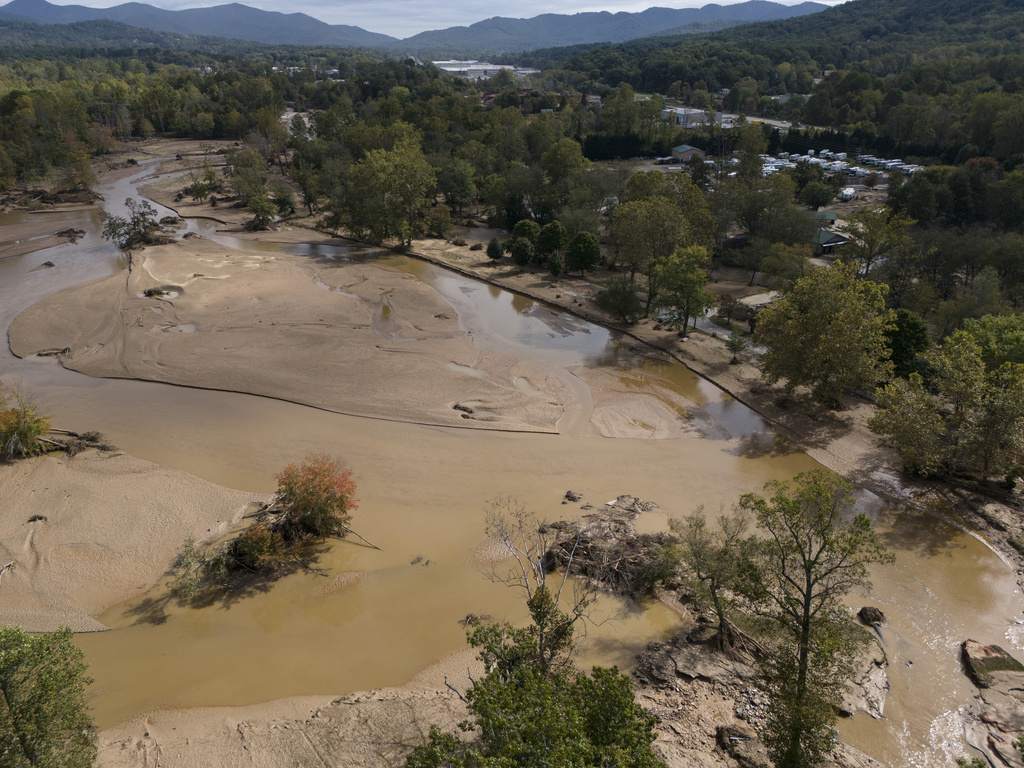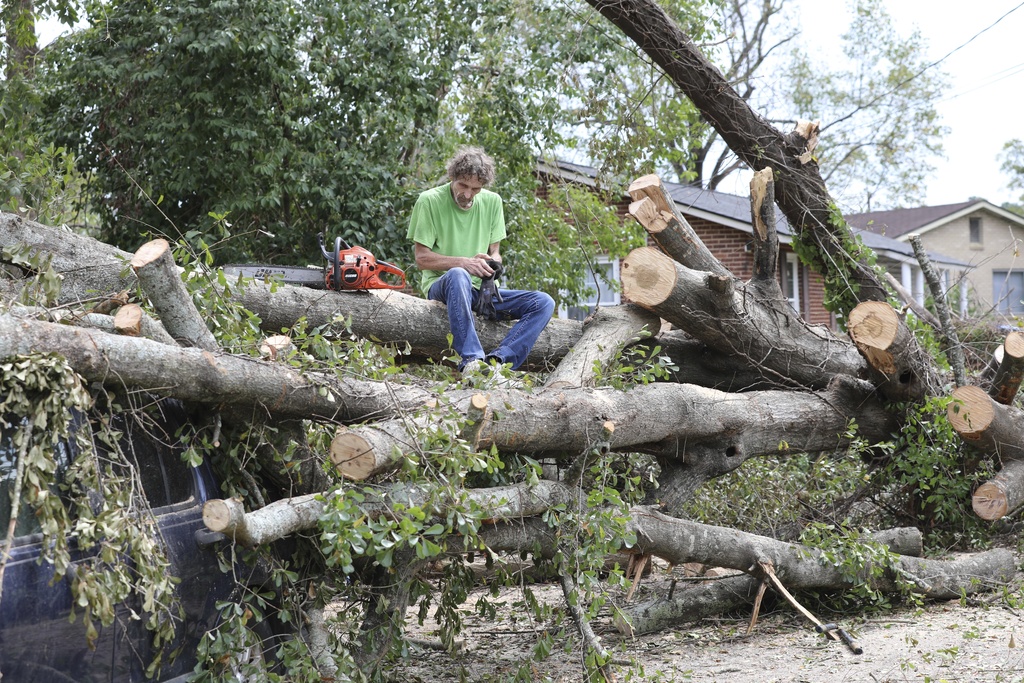Crews search for survivors in North Carolina’s mountains days after Helene’s deluge
By SVI Staff
October 1, 2024

Water is seen outside the banks of the Swannanoa river in the aftermath of Hurricane Helene, Tuesday, Oct. 1, 2024, in Swannanoa, N.C. (AP Photo/Mike Stewart)
By ERIK VERDUZCO and JEFFREY COLLINS Associated Press
SWANNANOA, N.C. (AP) — Cadaver dogs and search crews trudged through knee-deep muck and debris on Tuesday looking in the mountains of western North Carolina for victims of Hurricane Helene, days after the storm carved a deadly and destructive path through the Southeast.
With Helene’s death toll nearing 150, searchers fanned out across the region, using helicopters to get past washed-out bridges and hiking through wilderness to reach isolated homes.
Many who lived through what was one of the deadliest storms in U.S. history were left without electricity or any way to reach out for help. Some cooked food on charcoal grills or hiked to high ground in the hopes of finding a signal to call loved ones.
The devastation was especially bad in the Blue Ridge Mountains, where at least 50 people died in and around Asheville, a tourism haven known for its art galleries, breweries and outdoor activities.
Just outside the city, in the small community of Swannanoa, receding floodwaters revealed cars stacked on top of others and trailer homes that had floated away during the storm. Roads were caked with mud and debris and pockmarked by sinkholes.
Exhausted emergency crews worked around the clock to clear roads, restore power and phone service, and reach those still stranded by the storm, which killed at least 149 people in six states. Nearly half of the deaths were in North Carolina, while dozens of others were in South Carolina and Georgia.
“Communities were wiped off the map,” North Carolina’s governor, Roy Cooper, said Tuesday.
President Joe Biden was set to survey the devastation in the region Wednesday.
More than 150,000 households have already registered for assistance with the Federal Emergency Management Agency — a number that is expected to rapidly rise in the coming days, said Frank Matranga, an agency representative.
Nearly 2 million ready-to-eat meals and more than a million liters of water have been sent to the hardest-hit areas, he said.
The North Carolina death toll included one horrific story after another of people trapped by floodwaters or killed by falling trees. Among the dead were a couple and a 6-year-old boy who were waiting on a rooftop to when part of their home collapsed.
Search crews around Asheville first checked on the most vulnerable.”We’ve been going door to door, making sure that we can put eyes on people and see if they’re safe,” said Avril Pinder, the county manager for Buncombe County, which includes Asheville. “We know that there are places that are still hard to access.”

Andy Brown takes a break on top of what remains of a tree that destroyed his SUV when it fell during Hurricane Helene on in Augusta, Ga., Tuesday, Oct. 1, 2024. (AP Photo/Jeffrey Collins)
How some of the hardest-hit areas are coping
The storm unleashed the worst flooding in a century in North Carolina. Rainfall estimates in some areas have topped more than 2 feet (61 centimeters) since Wednesday, and several main routes into Asheville were damaged or blocked by mudslides.
A section of one of the region’s main arteries, Interstate 40, reopened Tuesday after a mudslide was cleared, but a collapsed stretch near North Carolina’s border with Tennessee remained closed.
Joey Hopkins, North Carolina’s secretary of transportation, asked people to stay off the roads so that emergency and recovery crews can get into the area.
At a grocery store in Asheville, Elizabeth Teall-Fleming stood in line hoping to find nonperishable food, since her home had no power. She planned to heat canned food over a camp stove for her family.
“I’m just glad that they’re open and that they’re able to let us in,” she said.
She was surprised by the storm’s ferocity: “Just seeing the little bit of news that we’ve been able to see has been shocking and really sad.”
Helene blew ashore in Florida late Thursday as a Category 4 hurricane and quickly moved north. The storm upended life throughout the Southeast, where deaths were also reported in Florida, Tennessee and Virginia. Officials warned that rebuilding would be long and difficult.
Mobile service knocked out
The widespread damage and outages affecting key communications infrastructure left many people without stable access to the internet and cellular service, the Federal Communications Commission said.
Teams from Verizon were working to repair downed cell towers, damaged fiber cables and provide alternative forms of connectivity across the region, the company said in a statement.
AT&T, meanwhile, said it launched “one of the largest mobilizations of our disaster recovery assets for emergency connectivity support.”
The efforts to restore service was made more challenging by the region’s terrain and spread-out population, said David Zumwalt, president and CEO of the Association for Broadband Without Boundaries.

A search and rescue dog and handler searches for victims in deep mud in the aftermath of Hurricane Helene, Tuesday, Oct. 1, 2024, in Swannanoa, N.C. (AP Photo/Mike Stewart)
Why western North Carolina was hit so hard
Western North Carolina suffered relatively more devastation because that’s where the remnants of Helene encountered the higher elevations and cooler air of the Appalachian Mountains, causing even more rain to fall.
Asheville and many surrounding mountain towns were built in valleys, leaving them especially vulnerable to devastating rain and flooding. Plus, the ground already was saturated before Helene arrived, said Christiaan Patterson, a meteorologist with the National Weather Service.
Climate change has exacerbated conditions that allow such storms to thrive, rapidly intensifying in warming waters and turning into powerful cyclones, sometimes within hours.
Destruction from Florida to Virginia
Across Georgia, Helene’s inland path knocked out power and shattered lives from Valdosta to Augusta, where a line of cars waiting to get water Tuesday wrapped around a shopping center and stretched at least a half-mile (0.8 kilometers) down the road.
“It’s been rough,” said Kristie Nelson, who had no idea when her electricity would be restored. “I’m just dying for a hot shower.”
Tennessee Gov. Bill Lee flew to the eastern part of that state to survey damage on Tuesday. During a stop while looking at what remained of a demolished high school, residents said the governor and his entourage were the first help they had seen since the storm hit.
“Where has everyone been? We have been here alone,” one frustrated local said.
With at least 31 killed in South Carolina, Helene was the deadliest tropical cyclone to hit the state since Hurricane Hugo made landfall north of Charleston in 1989, killing 35 people.
Tropical Storm Kirk could become a major hurricane
Tropical Storm Kirk is churning in the eastern Atlantic Ocean and is expected to become a hurricane late Tuesday. It could become a major hurricane Thursday, the U.S. National Hurricane Center said. The storm was about 1,010 miles (1,630 kilometers) west of the Cabo Verde Islands with maximum sustained winds of 70 mph (110 kph). There were no coastal watches or warnings in effect, and the storm system was not a threat to land.
___
Collins reported from Asheville. Contributing to this report were Associated Press journalists Gary D. Robertson in Raleigh; Kimberlee Kruesi in Hampton, Tennessee, Rebecca Santana in New Orleans, Shawn Chen in New York; and John Seewer in Toledo, Ohio.

